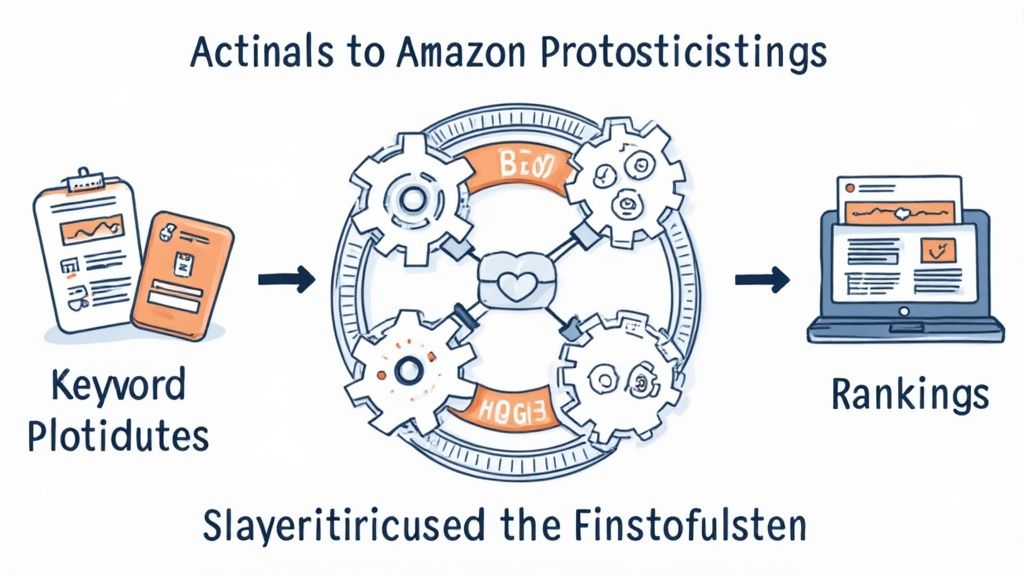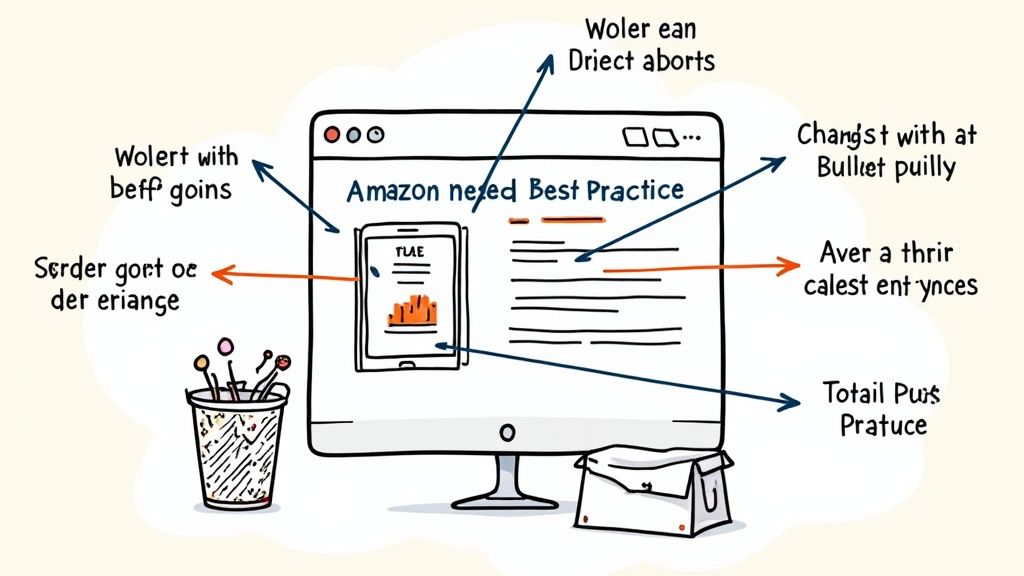Decoding Amazon’s Search Algorithm: What Drives Rankings

At its core, Amazon’s search algorithm works like a smart shopper with clear priorities. It aims to match customers with the perfect products for their needs, as quickly as possible. Learning how this algorithm thinks and acts is key to optimizing your Amazon listings effectively.
Beyond Traditional SEO: The Amazon Difference
While some basic SEO principles apply, Amazon’s approach is unique. For example, stuffing listings with keywords – a practice sometimes used in regular SEO – will hurt your rankings on Amazon. The platform puts customer experience first, so the algorithm rewards content that is relevant and helpful to shoppers. This means keyword research needs to focus on understanding customer intent and using targeted long-tail keywords, rather than just chasing high search volumes.
Key Drivers of Amazon Search Rankings
Several main factors determine how the algorithm ranks product listings:
- Sales Velocity: This measures how often and how much your product sells. Products that sell faster tend to rank higher in search results. This creates a cycle where better rankings lead to more visibility and sales, which further improves ranking. Between two similar listings, the one selling more quickly will usually appear first.
- Click-Through Rate (CTR): This shows how many people click on your listing when they see it in a search. High CTR tells Amazon your listing matches what shoppers want. To increase CTR, focus on strong titles, main images, and competitive pricing.
- Conversion Rate: This indicates how many clicks turn into purchases. Good conversion rates show Amazon your listing effectively meets customer needs. Clear product descriptions, quality images, and smart pricing help drive conversions.
- Customer Reviews: Both the number and quality of reviews matter for rankings. Positive reviews build trust with shoppers and influence buying decisions. Having a solid review strategy helps improve your listing’s visibility.
Aligning Your Strategy for Success
Success on Amazon requires more than basic keyword optimization. Focus on creating an excellent shopping experience through detailed product images, clear descriptions highlighting benefits, and competitive pricing. These elements boost two key ranking factors – conversion rates and sales velocity. Additionally, encouraging authentic positive reviews helps build trust and visibility. By understanding and optimizing for these core components, you can significantly improve your product’s discoverability and drive more sales.
Strategic Keyword Research That Actually Converts

Getting your product found on Amazon requires more than just understanding the search algorithm – it demands smart keyword research focused on what real shoppers are typing into the search bar. Simply using basic keyword tools won’t cut it. You need to dig deep into your target audience’s search behavior to drive meaningful results.
Understanding Search Intent: Beyond the Keyword
Good keyword research means understanding why people search, not just what they search for. Take running shoes as an example – someone searching for “running shoes” likely has different intentions than someone looking for “best trail running shoes for women.” The second search shows a buyer who knows exactly what they want and is ready to purchase. This kind of search intent insight helps turn browsers into buyers.
Rather than chasing high-volume keywords like “running shoes,” focus on specific long-tail phrases that signal buying intent. While these terms may have lower search volumes, they often deliver better results since they reach people actively looking to buy your specific type of product. A smaller but more qualified audience tends to generate more sales than large amounts of untargeted traffic.
Balancing Search Volume and Competition
Success with Amazon SEO means finding keywords with the right mix of search volume and competition level. The most searched terms are naturally crowded with competitors. Instead of trying to compete for these broad terms, look for more specific keywords with moderate search volume but less competition. This targeted approach helps your products stand out to the right customers.
Identifying Seasonal Trends and Emerging Keywords
Getting ahead means spotting trends before they peak. Winter clothing searches surge in cold weather months, for instance. By optimizing listings early for seasonal terms, you can capture that traffic before competitors catch on. Tools like Google Trends and Amazon’s search data reveal these patterns. Pay attention to new feature-related terms in your product category too. According to Jungle Scout, over half of online product searches start on Amazon, making visibility critical for sales success.
Implementing Keywords Strategically Across Your Listings
Once you’ve identified your target keywords, strategic placement is key. Don’t just stuff them everywhere – use them thoughtfully:
- Product Title: Include your most important keywords
- Bullet Points: Weave keywords naturally into feature descriptions
- Product Description: Add relevant terms while keeping content readable
- Backend Keywords: Use this hidden field for additional search terms
By taking this focused approach to keyword research and implementation, you can improve your products’ visibility and connect with motivated buyers. According to Feedvisor, optimized listings that follow SEO best practices see higher engagement and sales conversion rates.
Crafting Product Titles and Descriptions That Command Attention
Once you’ve identified your target keywords, the next essential step is creating compelling product titles and descriptions for your Amazon listings. These elements create that crucial first impression with potential buyers and significantly impact both click-through rates and sales conversions. Your title acts as the headline while your description serves as the sales pitch – both need to work together to grab attention and convince shoppers to buy.
Optimizing Your Product Title for Search and Clicks
The product title is what catches a shopper’s eye first, making it a critical element of your listing. You need to thoughtfully incorporate relevant keywords while keeping it concise and readable. Getting this balance right helps you rank well in Amazon’s search results while appealing to human shoppers. Research by Feedvisor shows products on Amazon’s first page have an average 16% conversion rate, highlighting how vital an optimized title is for visibility and clicks.
A good product title follows a clear format. Start with your brand name to build recognition, then include the product name and key features like color, size or quantity. For example, rather than just “Blue Pillow Cases”, use “Good Sleep Collection Pillowcases (Blue, Set of 2)”. This provides shoppers with essential details at a glance – the brand, collection name, color and quantity.
Writing Compelling Product Descriptions That Convert
While the title grabs attention initially, the product description provides the detailed information buyers need to make a purchase decision. Here’s where you go beyond listing features to highlight the real benefits. Instead of just stating “waterproof material”, explain how it protects belongings in rainy weather. This resonates with customers by showing how the product solves their problems or improves their lives.
The description also provides an opportunity to naturally work in secondary keywords. However, avoid overloading the text with keywords as this hurts readability and can negatively impact your Amazon SEO. Focus on highlighting value while strategically incorporating relevant search terms.
Using Bullet Points to Showcase Key Features and Benefits
Bullet points make it easy for shoppers to scan and understand key product features and benefits. They complement the main description by providing a quick overview. Use action-oriented language that emphasizes value. Rather than “Durable construction”, say “Built to withstand daily wear and tear”. This transforms technical specs into tangible benefits that connect with buyers.
Utilizing Backend Keywords for Enhanced Discoverability
Amazon allows sellers to add hidden backend keywords, providing another way to improve product visibility. This space works well for synonyms, abbreviations and alternate phrases shoppers might search for. For a yoga mat listing, you could include backend terms like “exercise mat”, “fitness mat” or “Pilates mat”. These expand your reach without cluttering the visible listing.
By combining an attention-getting title with persuasive description copy, scannable bullet points and strategic backend keywords, you can significantly boost both visibility and sales. The key is creating listings that satisfy both Amazon’s algorithm and human shoppers. With over half of online product searches now starting on Amazon according to Jungle Scout, optimized listings are essential for capturing attention and driving conversions.
Visual Optimization: Beyond Basic Product Photography

When it comes to Amazon listings, compelling product titles and descriptions are essential for SEO – but they’re just one piece of the puzzle. Your visual content creates that crucial first impression that can make or break a sale. Moving beyond basic product photography requires a strategic approach that enhances your brand, strengthens ranking signals, and builds real trust with customers.
The Power of Visual Storytelling
Just as an eye-catching book cover draws readers in, your product images need to tell a compelling story. Rather than showing a simple coffee mug shot, create a scene that shows it being enjoyed in a cozy setting – highlighting its size, design, and the warm experience it delivers. This emotional connection matters, especially since over half of online product searches now start on Amazon. Standing out visually is key to capturing attention in crowded search results.
Optimizing Your Main Image: The First Impression
Think of your main product image as your storefront window – it needs to immediately grab attention and invite shoppers in. High-resolution photos against a clean white background let customers focus on your product without distractions, creating that professional first impression. Getting this right leads to better click-through rates, which directly impacts your position in Amazon’s search rankings.
Leveraging A+ Content: Enhancing Brand and Conversion
A+ Content provides powerful visual storytelling tools beyond basic descriptions for brands registered with Amazon Brand Registry. Like an in-store product display, you can use rich visuals to showcase key features, answer common questions, and bring your brand story to life. Side-by-side comparison charts, lifestyle photos, and product videos give shoppers a complete understanding, addressing concerns upfront and showing your product in real-world use.
Visual Optimization Across Categories and Price Points
The best visual strategy varies based on what you’re selling and your target price point. Clothing and home decor often benefit from lifestyle imagery that shows the items in use. Higher-end electronics may need detailed close-ups highlighting premium materials and craftsmanship. More expensive items typically warrant comprehensive visual content – including videos and 360-degree views – to justify the investment. By aligning your visuals with both product features and customer expectations, you can maximize impact and drive more conversions through your Amazon listings.
Building Trust Through Strategic Review Management
Reviews are the heartbeat of success on Amazon, going far beyond just collecting 5-star ratings. They represent real customer experiences that shape buying decisions and search rankings. In this section, we’ll explore proven methods to encourage genuine reviews, handle feedback effectively, and use customer insights to improve your visibility.
The Importance of Reviews for SEO and Conversions
Reviews impact both Amazon’s search algorithm and customer decisions in powerful ways. When you have more positive reviews, your products naturally rank higher and catch more shopper attention. Think about this: if two similar products compete, and one has 200 reviews with a 4.5-star rating while the other has just 20 reviews and 4 stars, Amazon will likely favor the first product since it demonstrates stronger customer satisfaction. Plus, those positive reviews give potential buyers the confidence to make a purchase, directly boosting your sales.
Encouraging Authentic Reviews: Staying Within Amazon’s Guidelines
Getting reviews requires a careful approach that follows Amazon’s rules. Never offer incentives or try to manipulate reviews – this can lead to serious consequences like account suspension. Instead, focus on delivering excellent products and customer service that naturally inspire buyers to leave feedback. Make good use of Amazon’s built-in tools, like the “Request a Review” button, which lets you send standardized review requests to customers in a compliant way.
Managing Negative Reviews: Turning Challenges Into Opportunities
Every seller gets negative reviews at some point, but they don’t have to hurt your business. See them as chances to learn and get better. When you get critical feedback, respond quickly and professionally to address concerns and offer solutions. For instance, if someone reports receiving damaged goods, promptly offering a replacement shows other potential buyers that you stand behind your products and care about customer satisfaction. You can also use negative feedback to identify areas for improvement in your products or services.
Leveraging Customer Feedback for Continuous Listing Optimization
Reviews provide insights that go beyond star ratings. Pay attention to what customers specifically praise or criticize about your products. This feedback helps you refine your product descriptions, highlight key features, and address common questions. For example, if multiple reviewers mention how easy a product is to use, make that benefit prominent in your title and bullet points. Regularly incorporating this kind of customer feedback creates an ongoing cycle of improvements that lifts both your search rankings and sales performance.
Performance Tracking and Optimization Maintenance

Succeeding on Amazon requires more than just setting up your listings and walking away. Like tending a garden, your product listings need regular care and attention to stay visible and drive sales. This section explores practical ways to track your performance and keep your listings optimized over time.
Identifying Key Performance Indicators (KPIs)
To improve your Amazon listings, you need to focus on metrics that directly impact your bottom line. Instead of getting caught up in superficial numbers like page views, pay attention to these core indicators:
- Conversion Rate: The percentage of visitors who purchase after clicking your listing. For example, if 100 people view your listing and 15 buy, you have a 15% conversion rate. A strong conversion rate shows your listing connects with shoppers.
- Click-Through Rate (CTR): The frequency of clicks when your listing appears in search results. A good CTR means your title and main image catch shoppers’ attention. According to Feedvisor, first-page listings average 16% higher conversion rates.
- Keyword Ranking: Your product’s position for target search terms reveals if your optimization efforts work. Jungle Scout research shows well-optimized listings can boost sales by 70%.
- Sales Velocity: How quickly your product sells in a given timeframe. For instance, selling 50 units weekly signals stronger performance to Amazon’s algorithm than selling just 10 units.
Utilizing Amazon’s Analytics Tools and Third-Party Software
Amazon provides several built-in tools to track performance, including Brand Analytics for insights into search trends and customer behavior. Many third-party tools also offer detailed analytics and competitor monitoring. These tools help you spot areas for improvement and react to market shifts – for example, getting alerts when competitors change prices or launch new products.
Adapting to Marketplace Changes and Algorithm Updates
The Amazon marketplace constantly evolves through algorithm updates, seasonal trends, and competitive moves. Success requires staying informed and nimble. For example, if Amazon starts favoring video content, you can quickly add product videos to gain an edge over slower-moving competitors.
Continuous Optimization: A Cycle of Improvement
Effective Amazon optimization means constantly monitoring, analyzing, and adjusting your listings. This includes:
- Regularly reviewing key metrics
- Testing different titles and descriptions
- Tracking results of changes
- Making data-driven refinements
This ongoing cycle helps ensure your listings stay optimized for both Amazon’s algorithm and customer expectations.
Boost your Amazon sales and optimize your product listings with eStore Factory, a leading eCommerce agency with over 10 years of experience and a proven track record of success. Visit eStore Factory today to learn how their expert team can help you achieve your Amazon selling goals.

